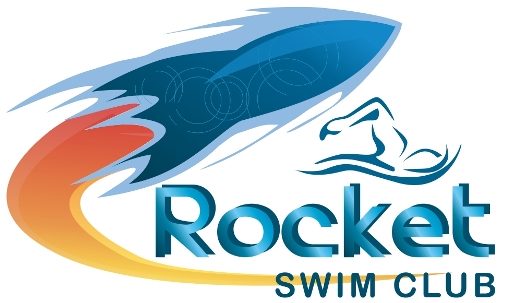You can see lots of different techniques in Swimming. Freestyle is one of them.
Freestyle is the fastest, most efficient swimming technique – but only when done correctly.
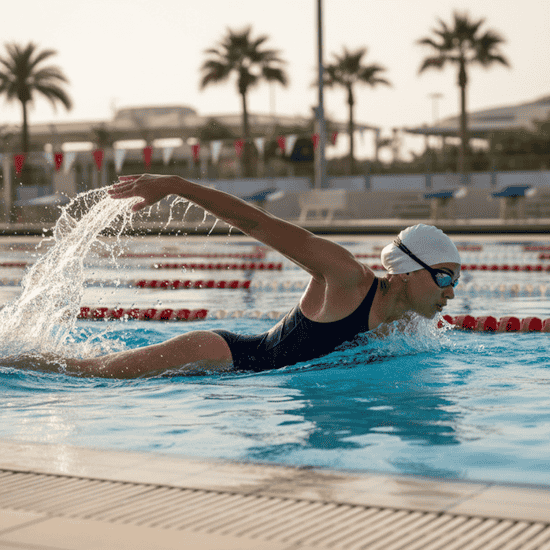
Whether you’re learning your first stroke, training for competition, coaching others, or returning to swimming after years away, this comprehensive guide covers every aspect of freestyle swimming.
What you’re going to explore:
Stroke Technique: Body position, arm mechanics, breathing patterns, kick timing, stroke coordination
Training Drills: Catch drills, breathing exercises, kick sets, stroke count reduction, distance building
Pacing & Performance: Interval training, race strategy, stroke rate optimization, open water technique
Rules & Standards: Competition regulations, pool protocols, equipment requirements, training benchmarks
Problem Solutions: Sinking issues, breathing difficulties, shoulder pain, energy waste, stroke timing
Let’s dive in-
What is Freestyle in Swimming?
Freestyle (also known as front crawl stroke) is the fastest and most versatile swimming stroke. When you watch Olympic swimmers swim effortlessly through water, that’s freestyle.
This stroke dominates competitive swimming because it’s the most efficient way to move through water. In freestyle, your body stays horizontal and streamlined while one arm pulls underwater as the other recovers above water where breathe by rotating your head to the side, keeping goggle in the water.
What makes freestyle special is its adaptability. Beginners can swim it slowly for fitness. Sprinters can power through 50 meters. Distance swimmers can maintain it for miles. Triathletes rely on it for open water races.
The stroke combines four elements: body position, arm movement, kicking, and breathing. Mastering these fundamentals will help you swim faster with less effort.
Freestyle Swimming Stroke Benefits
Freestyle delivers unmatched cardiovascular fitness, muscle development, and joint protection while burning more calories per hour than most land-based exercises.
This stroke transforms your entire body into a powerful, efficient machine. Unlike running or cycling, freestyle works your upper body, core, and legs simultaneously while protecting your joints from impact stress.
Freestyle is more than just speed. It offers:
| Physical Benefits: | Performance Benefits: | Long-term Health Benefits: |
|---|---|---|
| Burns 400-700 calories per hour depending on intensity | Develops bilateral coordination between arms and legs | Low-impact exercise suitable for all ages |
| Builds lean muscle in shoulders, back, core, and legs | Improves balance and body awareness in water | Reduces risk of injury compared to high-impact activities |
| Improves cardiovascular endurance without joint strain | Builds mental focus through breathing rhythm | Maintains mobility and strength as you age |
| Increases lung capacity through rhythmic breathing patterns | Creates efficient movement patterns for other sports | Provides stress relief through meditative breathing |
| Enhances flexibility and range of motion |
Freestyle swimming offers complete fitness benefits no other single exercise can match.
What are the Important Elements of Freestyle Stroke
Four critical elements determine freestyle efficiency. Those are
- Body position,
- Arm stroke,
- Kick, and
- Breathing coordination.
Body Position
A streamlined body position minimizes drag and helps conserve energy.
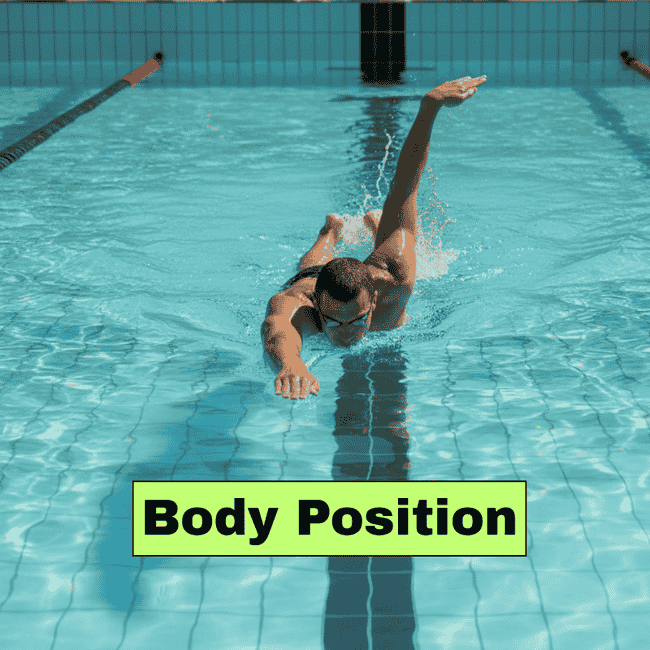
Keep your head aligned with your spine and your body as flat as possible on the water’s surface.
Breathing
Exhale underwater and inhale quickly when turning your head to the side.
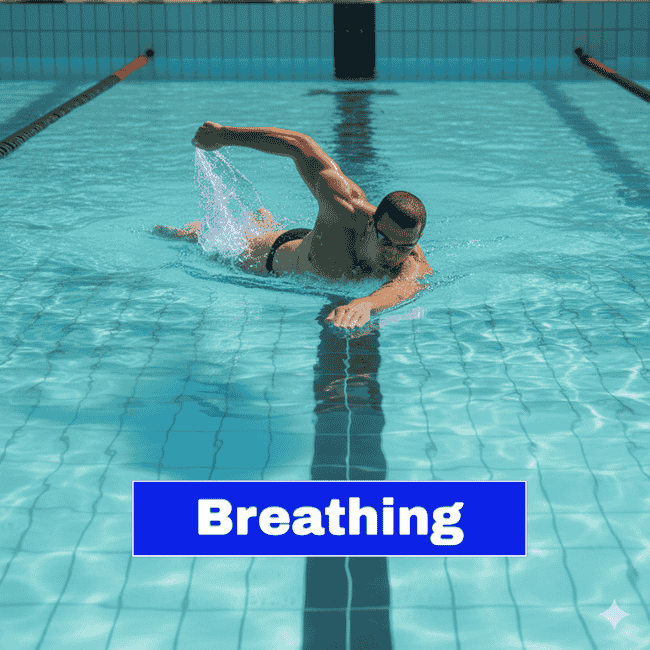
Efficient breathing keeps your rhythm smooth and avoids oxygen debt.
Kick
A steady flutter kick from the hips, not the knees, drives propulsion and balance.
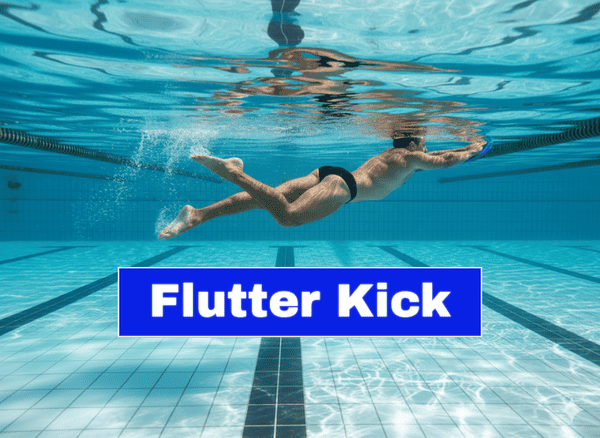
Aim for small, fast kicks instead of big splashes.
Arm Stroke
Your arms generate most of the power in freestyle. Each stroke cycle has several parts:
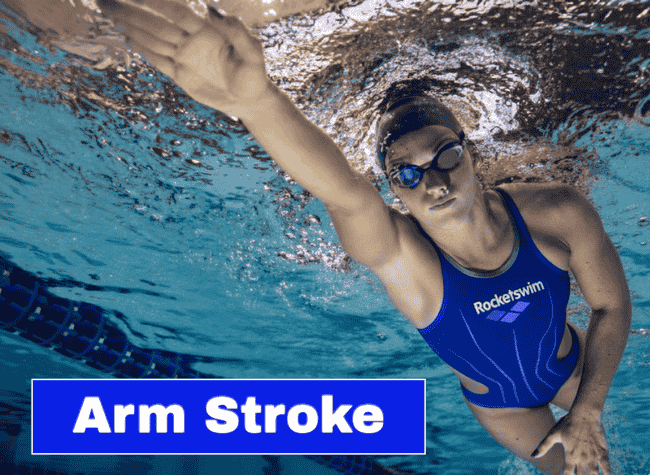
Entry Fingers enter the water first, slightly in front of the shoulder.
More important elements to look for:
Catch
Engage your forearm and hand to “catch” the water, setting up for the pull.
Pull
Push water backward in an S-shaped path to maximize propulsion.
Timing
Coordinate arms, legs, and breathing to create smooth, continuous motion.
Rotation & Balance
Rotating your hips and shoulders with each stroke helps extend reach and reduce drag while keeping balance in the water.
Each element affects the others – fix one by one and your entire stroke could be improved.
Important Freestyle Swimming Drills to Improve Technique
These five proven drills fix the most common freestyle problems and build muscle memory for perfect technique. Practice them weekly to see immediate stroke improvements.
Six Kick Switch Drill
Hold streamline position, kick 6 times, then take one stroke and rotate to opposite side. This will improve your body rotation timing and kick-stroke coordination.
Catch-Up Drill
One arm extended forward while other arm completes full stroke cycle. Improves timing and forces proper body rotation. Start with 25-meter repeats, breathe every 3 strokes.
One Arm Freestyle
Improves technique on each side independently. Swim with one arm only, other arm at side or extended. This will improve your arm strength and makes high elbow catch position better. Change your arms every 25 meters.
Fingertip Drag
During arm recovery, drag fingertips across water surface. Forces high elbow position and prevents over-reaching. Perform at 70% normal speed.
Side Kick Drill
Enhances breathing and body position awareness.
Comparison Between Freestyle Vs Other Swimming Strokes
Freestyle vs Breaststroke
Freestyle is 30% faster than breaststroke and burns more calories, but breaststroke offers easier breathing and better visibility for beginners learning proper swimming form. Lets see some major differences between them
| Elements | Freestyle | Breaststroke |
|---|---|---|
| Speed and Efficiency | Freestyle maintains continuous propulsion through alternating arm strokes. | Breaststroke has glide phases that reduce speed. |
| Breathing Technique | Freestyle requires side breathing with head rotation, keeping body streamlined. | Breaststroke allows natural forward breathing by lifting head above water, making it easier for nervous swimmers. |
| Body Position | Freestyle keeps horizontal position throughout stroke cycle. | Breaststroke involves vertical head/chest lifting that creates drag but provides better pool awareness and navigation. |
| Muscle Groups | Freestyle engages shoulders, lats, and core through rotation. | Breaststroke emphasizes chest, inner thighs, and glutes through simultaneous arm/leg movements, building different strength patterns. |
If you want speed and fitness go with freestyle while breaststroke for comfort and technique development.
Freestyle vs Butterfly
Butterfly uses more energy and requires simultaneous arm movement, whereas freestyle is more efficient for distance. Lets see some major differences between them
| Elements | Freestyle | Butterfly |
|---|---|---|
| Energy Expenditure | Freestyle burns 488 calories per hour | Butterfly burns 773 calories per hour |
| Technical Complexity | Freestyle alternates arms independently with flexible breathing patterns. | Butterfly requires precise synchronization between both arms and dolphin kick timing, plus breathing only during arm recovery phase. |
| Muscle Recruitment | Freestyle distributes workload across alternating sides. | Butterfly simultaneously engages entire upper body, core, and legs, creating explosive power but overwhelming smaller stabilizing muscles quickly. |
| Practical Application | Freestyle works for fitness, distance, and daily training. | Butterfly primarily serves competitive sprinting and strength building, requiring excellent conditioning before attempting full strokes. |
Choose freestyle for endurance and versatility, butterfly for power development and competition.
Freestyle vs Backstroke
Backstroke uses similar body rotation principles to freestyle but swims face-up, offering unlimited breathing access while creating more drag and requiring different visual navigation strategies.
| Elements | Freestyle | Backstroke |
|---|---|---|
| Propulsion Mechanics | Freestyle generates superior propulsion because arms work in stronger positions with less drag resistance. | Backstroke creates more drag and less propulsion due to weaker arm positions. |
| Breathing Requirements | Freestyle demands coordinated breathing with head turns, creating technique complexity but maintaining streamlined body position. | Backstroke provides the advantage of easy breathing since you're face-up, eliminating the need for breath timing or head rotation. |
| Body Position Stability | Backstroke emphasizes relaxation and stability, making it excellent for leisurely swimming. | |
| Practical Applications | Freestyle dominates competitive and fitness swimming due to its speed and practical navigation advantages. | Backstroke serves as a relaxed swimming technique or survival method. |
Go with backstroke for breathing comfort and stroke learning, freestyle for speed and real-world swimming situations.
How to Get Faster at Freestyle
Swimming freestyle faster requires reducing drag while increasing propulsion through technical improvements, consistent training, and smart race tactics applied systematically. Below are some steps you could follow:
- Focus on technique before power.
- Improve streamline off walls and starts.
- Train aerobic and anaerobic systems.
- Use resistance tools like paddles and fins in moderation.
- Maintain consistent kick tempo.
Common Mistakes Swimmers Make at Freestyle
These five technique errors slow down 90% of freestyle swimmers and create unnecessary fatigue, shoulder pain, and poor performance in pools. Those are-
- Crossing arms over the midline (crossover).
- Breathing late or holding breath too long.
- Kicking from knees instead of hips.
- Dropping elbows during pull.
- Lifting head too high when breathing.
Top Canadian Freestyle Swimmers to Follow
Summer McIntosh
Summer McIntosh is Canada’s 17-year-old swimming sensation who became the first Canadian athlete to win three gold medals at a single Olympic Games during Paris 2024.
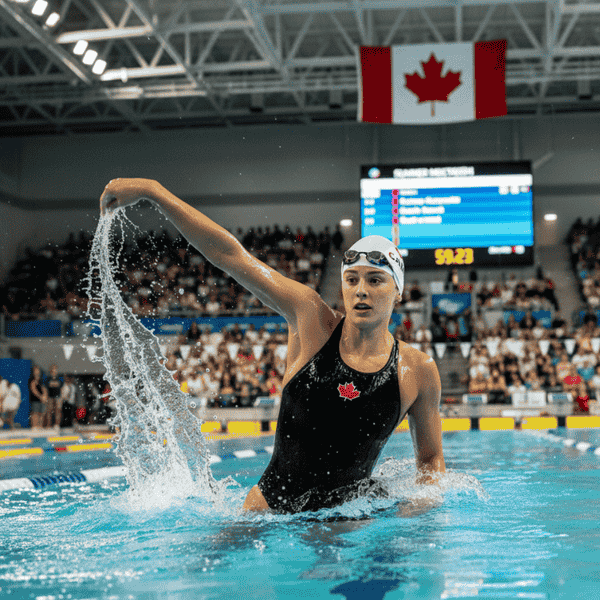
The 2024 World Aquatic Swimmer of the Year dominates butterfly, individual medley, and freestyle events with multiple world records.
Penny Oleksiak
Penny Oleksiak is Team Canada’s all-time most decorated Olympian with seven Olympic medals, who became the youngest Canadian to win Olympic gold at 16 years and 59 days at the 2016 Rio Olympics.
Ilya Kharun
Ilya Kharun is Canada’s 19-year-old butterfly specialist who captured double Olympic bronze medals at Paris 2024, becoming the breakout male swimmer of the year. Born to Ukrainian acrobat parents in Montreal, he swims for Arizona State University and holds multiple Canadian records.
Want to improve your freestyle stroke like them and be an Olympic gold medalist?
Join Rocket Swim Club in Toronto, where swimmers train with expert coaches to master these techniques, build endurance, and achieve personal bests.
Freestyle Swimming FAQs
How do you fix freestyle crossover?
Focus on hand entry directly in front of your shoulder, not across your head. Use drills like the
long dog or one-arm freestyle.
What is EVF in freestyle?
EVF stands for Early Vertical Forearm, a pulling technique that maximizes propulsion.
How do I increase my freestyle speed?
Work on stroke efficiency, strong kick tempo, and proper breathing rhythm. Interval training
helps too.
How to learn freestyle stroke for beginners?
Start with floating and kicking drills, then add arm movements. Practice breathing separately
before combining everything.
When does RocketSwim’s new season start?
Our new season kicks off this September.
Is RocketSwim’s new season registration open now?
Yes! Registration is currently open.
How can I join RocketSwim for the new season?
Visit rocketswim.com to register and secure your spoot

